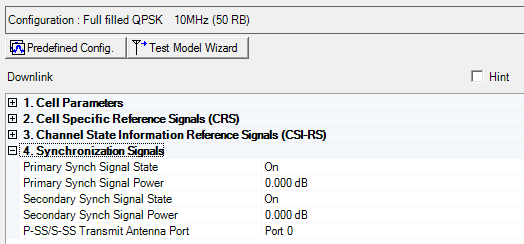
Two types of synchronization signals are used for the downlink in LTE:
Primary synchronization signal (P-SS)
The primary synchronization signal is used to synchronize timing during cell search.
Secondary synchronization signal (S-SS)
The secondary synchronization signal is used to synchronize timing and to transmit cell group identification during cell search.
Additional Downlink parameters are described in Cell Parameters (Basic LTE-A FDD Downlink), Cell Specific Reference Signal (Basic LTE-A- FDD Downlink), and Channel State Information Reference Signal Parameters (Basic LTE-A FDD Downlink).

Choice: Off | On
Default: On
The software sets the state of the primary synchronization signal (P-SS) to . You can control the P-SS power as described below.
Range: -60.000 to 20.000 dB
Default: 0.000 dB
Enter the power level in dB for the primary synchronization signal, relative to the reference signal per resource element (i.e. when the reference signal power is set to 0 dB).
Choice: Off | On
Default: On
The software sets the state of the secondary synchronization signal (S-SS) to . You can control the S-SS power as described below.
Range: -60.000 to 20.000 dB
Default: 0.000 dB
Enter the power level in dB for the secondary synchronization signal, relative to the average subcarrier power..
Choice: Port 0 | Port 1 | Port 2 | Port 3 | All Port
Default: Port 0
Double-click or use the drop-down menu to select the P-SS/S-SS transmit antenna port.
This parameter specifies the antenna port(s) that P-SS and S-SS are transmitted on. P-SS and S-SS can be transmitted on a single antenna (Port0/1/2/3) or all the antenna ports.